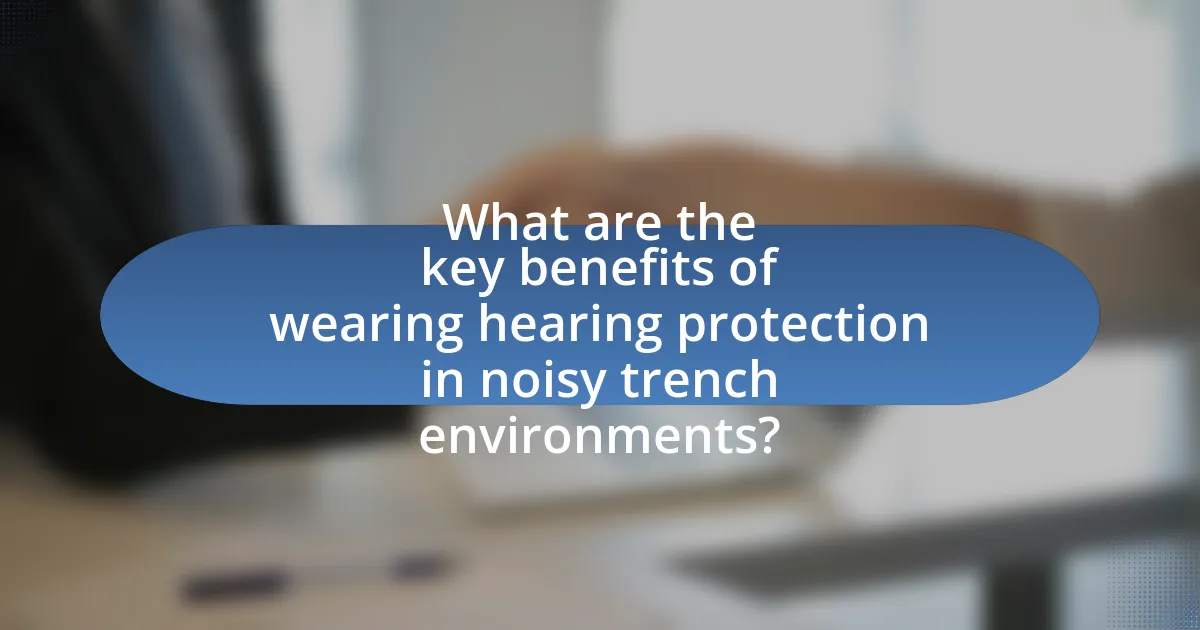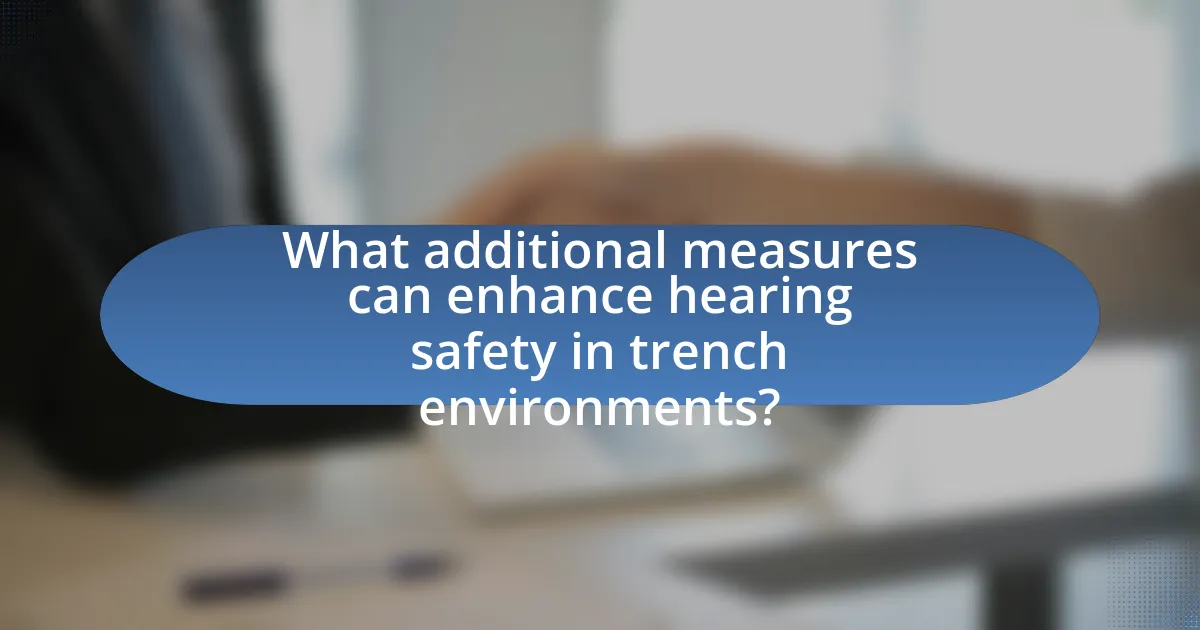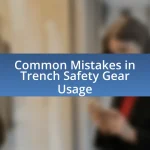The article focuses on the critical importance of wearing hearing protection in noisy trench environments, where noise levels often exceed 85 decibels, leading to a significant risk of noise-induced hearing loss (NIHL). It outlines the various types of hearing protection available, such as earplugs and earmuffs, and emphasizes the effectiveness of these devices in reducing auditory damage and enhancing communication among workers. Additionally, the article discusses the long-term consequences of inadequate hearing protection, best practices for selecting and maintaining hearing devices, and the role of workplace culture and training in promoting hearing safety. Overall, it highlights the necessity of consistent use of hearing protection to safeguard workers’ auditory health in high-risk environments.

What are the key benefits of wearing hearing protection in noisy trench environments?
Wearing hearing protection in noisy trench environments significantly reduces the risk of noise-induced hearing loss. Prolonged exposure to high decibel levels, often exceeding 85 dB in such settings, can lead to permanent damage to the auditory system. Studies indicate that consistent use of hearing protection can lower the incidence of hearing impairment by up to 50%. Additionally, hearing protection enhances communication and safety by minimizing distractions from loud machinery, allowing workers to remain alert to their surroundings. This is crucial in preventing accidents, as clear auditory signals are essential in high-risk environments.
How does excessive noise impact hearing in trench environments?
Excessive noise in trench environments can lead to permanent hearing loss and auditory damage. Prolonged exposure to high decibel levels, often exceeding 85 dB, can cause noise-induced hearing loss (NIHL), which is irreversible. Studies indicate that military personnel and construction workers in trenches frequently encounter noise levels that can reach up to 120 dB, significantly increasing the risk of auditory impairment. The World Health Organization states that consistent exposure to such noise levels can damage hair cells in the inner ear, leading to decreased hearing sensitivity and potential tinnitus.
What types of noise levels are typically found in trench environments?
Trench environments typically experience noise levels ranging from 85 to 120 decibels. These levels are primarily generated by machinery, equipment operation, and construction activities, which can lead to significant hearing risks for workers. For instance, the use of heavy machinery like excavators and jackhammers can produce noise levels exceeding 100 decibels, which is well above the threshold that can cause hearing damage over prolonged exposure. Studies indicate that consistent exposure to noise levels above 85 decibels can result in permanent hearing loss, underscoring the importance of wearing hearing protection in such environments.
How does prolonged exposure to noise affect hearing health?
Prolonged exposure to noise can lead to permanent hearing loss and other auditory health issues. Specifically, consistent exposure to sounds above 85 decibels can damage the hair cells in the inner ear, which are crucial for transmitting sound signals to the brain. Research indicates that approximately 15% of American adults report some degree of hearing loss, often linked to occupational noise exposure. Additionally, the World Health Organization states that noise-induced hearing loss is preventable through the use of hearing protection, especially in environments with high noise levels, such as construction sites or military trenches.
What types of hearing protection are available for trench workers?
Trench workers have access to several types of hearing protection, including earplugs, earmuffs, and noise-canceling headphones. Earplugs are designed to fit snugly in the ear canal, providing a high level of noise reduction, often rated at 20 to 30 decibels. Earmuffs cover the entire ear and can provide similar or greater noise reduction, making them suitable for extremely loud environments. Noise-canceling headphones actively reduce ambient noise, enhancing communication and safety while still protecting hearing. These options are essential for trench workers, as prolonged exposure to high noise levels can lead to permanent hearing loss, a risk highlighted by the National Institute for Occupational Safety and Health, which states that construction workers are at a higher risk of noise-induced hearing loss due to their work environment.
What are the different categories of hearing protection devices?
The different categories of hearing protection devices include earplugs, earmuffs, and semi-insert earplugs. Earplugs are small devices inserted into the ear canal to block sound, providing a portable and discreet option for noise reduction. Earmuffs consist of a headband with sound-attenuating cups that cover the entire ear, offering a higher level of protection in extremely noisy environments. Semi-insert earplugs combine features of both earplugs and earmuffs, providing a balance of comfort and noise attenuation. These categories are essential for protecting hearing in environments such as noisy trenches, where exposure to loud sounds can lead to permanent hearing damage.
How do various hearing protection devices differ in effectiveness?
Hearing protection devices differ in effectiveness primarily based on their design, material, and noise reduction rating (NRR). For instance, earplugs typically provide a higher NRR, often ranging from 20 to 30 decibels, making them more effective for blocking out high-frequency noise compared to earmuffs, which generally have an NRR of 15 to 25 decibels. Additionally, custom-molded earplugs can offer superior fit and comfort, leading to better noise attenuation in noisy environments like trenches. Research indicates that proper fitting and usage of these devices significantly enhance their protective capabilities, with studies showing that improperly fitted earmuffs can reduce their effectiveness by up to 50%.
Why is it crucial to wear hearing protection in trench environments?
Wearing hearing protection in trench environments is crucial to prevent noise-induced hearing loss. Trench work often exposes individuals to high decibel levels from machinery, tools, and environmental factors, which can exceed 85 decibels, the threshold where hearing damage can occur. Studies indicate that prolonged exposure to such noise levels can lead to permanent hearing impairment, making protective measures essential for workers’ long-term auditory health.
What are the long-term consequences of not using hearing protection?
Not using hearing protection can lead to permanent hearing loss, tinnitus, and increased risk of auditory processing disorders. Prolonged exposure to loud noise, such as that found in noisy trench environments, can damage the hair cells in the inner ear, resulting in irreversible hearing impairment. According to the Centers for Disease Control and Prevention (CDC), approximately 22 million workers are exposed to hazardous noise levels each year, contributing to significant long-term auditory health issues.
How can hearing protection improve overall safety in trench work?
Hearing protection can significantly improve overall safety in trench work by reducing the risk of hearing loss and enhancing communication among workers. In noisy environments, such as those found in trench work, prolonged exposure to high decibel levels can lead to permanent hearing damage, which can impair a worker’s ability to hear important safety signals or warnings. Studies indicate that effective hearing protection can lower noise exposure by up to 30 decibels, allowing workers to maintain awareness of their surroundings. Additionally, when workers can hear clearly, they can communicate more effectively, reducing the likelihood of accidents caused by misunderstandings or lack of awareness.

How can workers ensure they are using hearing protection effectively?
Workers can ensure they are using hearing protection effectively by selecting the appropriate type of hearing protection, ensuring a proper fit, and consistently wearing it in noisy environments. The selection of hearing protection should be based on the noise levels present, with options such as earplugs or earmuffs that provide adequate noise reduction ratings. A proper fit is crucial; poorly fitted devices can significantly reduce their effectiveness, as studies indicate that a good seal is necessary to block out harmful noise levels. Additionally, workers must wear hearing protection at all times in designated noisy areas, as intermittent use can lead to hearing damage. Regular training and reminders about the importance of hearing protection can further enhance compliance and effectiveness.
What are the best practices for selecting hearing protection?
The best practices for selecting hearing protection include assessing the noise levels in the environment, choosing the appropriate type of hearing protection, ensuring a proper fit, and considering the duration of exposure. Assessing noise levels involves measuring sound intensity in decibels (dB) to determine the necessary protection level; for example, environments exceeding 85 dB typically require hearing protection. Selecting the appropriate type, such as earplugs or earmuffs, depends on the specific noise hazards; earmuffs may provide better attenuation for high-frequency noise, while earplugs can be more comfortable for extended wear. Ensuring a proper fit is crucial, as poorly fitted devices can reduce their effectiveness; studies indicate that a snug fit can enhance noise reduction by up to 50%. Finally, considering the duration of exposure helps in selecting devices that not only protect but also allow for communication and comfort during prolonged use.
How should workers assess their specific noise exposure levels?
Workers should assess their specific noise exposure levels by using sound level meters or dosimeters to measure the intensity of noise in their work environment. These devices provide quantitative data on noise levels, allowing workers to identify areas where exposure exceeds safe limits, typically set at 85 decibels over an 8-hour period according to the Occupational Safety and Health Administration (OSHA). Regular monitoring and recording of noise levels help in understanding exposure patterns and implementing necessary hearing protection measures.
What factors should be considered when choosing hearing protection devices?
When choosing hearing protection devices, factors such as noise reduction rating (NRR), comfort, fit, and the specific noise environment must be considered. The NRR indicates the level of sound attenuation the device provides, which is crucial in noisy trench environments where sound levels can exceed 85 decibels, potentially causing hearing damage. Comfort and fit are essential for prolonged use; devices that do not fit well can lead to reduced effectiveness and increased discomfort. Additionally, the type of noise—whether it is continuous or impulsive—can influence the choice of device, as some protectors are better suited for specific noise types.
How can workers maintain their hearing protection devices?
Workers can maintain their hearing protection devices by regularly inspecting them for damage, cleaning them according to manufacturer guidelines, and replacing them when necessary. Regular inspections help identify wear and tear, ensuring that the devices provide adequate protection. Cleaning is essential to remove dirt and debris that can affect performance; for example, foam earplugs should be replaced after a certain number of uses, while earmuffs can be wiped down with a damp cloth. Following these maintenance practices ensures that hearing protection devices remain effective in reducing noise exposure in noisy trench environments.
What are the recommended cleaning and maintenance procedures?
The recommended cleaning and maintenance procedures for hearing protection in noisy trench environments include regular inspection, cleaning, and proper storage. Inspect hearing protection devices for any signs of wear, damage, or contamination before each use. Clean the devices according to the manufacturer’s instructions, typically using mild soap and water, and ensure they are completely dry before storage. Store hearing protection in a clean, dry place to prevent damage and contamination. These procedures help maintain the effectiveness of the devices, ensuring optimal protection against noise exposure.
How often should hearing protection devices be replaced?
Hearing protection devices should be replaced every 6 to 12 months, depending on usage and wear. Regular inspection for signs of damage, such as cracks or loss of cushioning, is essential to ensure optimal performance. Research indicates that worn-out hearing protection can significantly reduce its effectiveness, leading to increased risk of hearing loss in noisy environments, such as trenches.

What additional measures can enhance hearing safety in trench environments?
Implementing engineering controls, such as noise barriers and sound-dampening materials, can significantly enhance hearing safety in trench environments. These measures reduce the overall noise exposure by blocking or absorbing sound waves, thereby lowering the risk of hearing damage. According to the National Institute for Occupational Safety and Health (NIOSH), using such controls can decrease noise levels by up to 10 decibels, which is a substantial reduction that can protect workers’ hearing. Additionally, regular monitoring of noise levels and providing training on the importance of hearing protection further contribute to a safer auditory environment.
How can training improve awareness of hearing protection?
Training can significantly improve awareness of hearing protection by educating individuals about the risks of noise exposure and the importance of using protective equipment. Effective training programs provide information on how prolonged exposure to high noise levels can lead to irreversible hearing loss, emphasizing that approximately 22 million workers are exposed to hazardous noise levels each year in the United States alone. Additionally, training can demonstrate the proper use and maintenance of hearing protection devices, ensuring that individuals understand how to effectively reduce noise exposure. By incorporating real-life scenarios and statistics, such as the fact that hearing loss is one of the most common work-related injuries, training fosters a culture of safety and encourages proactive behavior regarding hearing protection in noisy environments like trenches.
What topics should be covered in hearing safety training sessions?
Hearing safety training sessions should cover the importance of hearing protection, types of hearing protection devices, noise exposure levels, the effects of noise on hearing, proper use and maintenance of hearing protection, and legal requirements for hearing conservation programs. These topics ensure that participants understand the risks associated with noise exposure in environments like noisy trenches, where prolonged exposure can lead to permanent hearing loss. Research indicates that effective hearing conservation programs can reduce the incidence of noise-induced hearing loss by up to 25%, highlighting the necessity of comprehensive training on these subjects.
How can workers be encouraged to consistently use hearing protection?
Workers can be encouraged to consistently use hearing protection by implementing a combination of training, incentives, and accessibility measures. Training programs that educate workers on the risks of noise exposure and the benefits of hearing protection can significantly increase awareness and compliance. For instance, studies show that workers who receive proper training are 50% more likely to use hearing protection consistently. Additionally, providing incentives such as recognition programs or rewards for consistent use can motivate workers to prioritize their hearing safety. Ensuring that hearing protection devices are easily accessible and comfortable to wear also plays a crucial role; research indicates that when protective equipment is readily available, usage rates increase by up to 30%.
What role does workplace culture play in hearing safety?
Workplace culture significantly influences hearing safety by establishing norms and practices that prioritize employee well-being. A positive workplace culture fosters awareness and encourages the use of hearing protection, which is essential in noisy environments like trenches where sound levels can exceed 85 decibels, leading to potential hearing loss. Research indicates that organizations with strong safety cultures report lower incident rates; for instance, a study published in the Journal of Occupational Health Psychology found that companies with proactive safety cultures had 50% fewer workplace injuries. This demonstrates that when a culture emphasizes safety, employees are more likely to adopt protective measures, thereby enhancing hearing safety.
How can management promote a culture of hearing safety?
Management can promote a culture of hearing safety by implementing comprehensive training programs that educate employees about the risks of noise exposure and the importance of hearing protection. Research indicates that organizations with effective training see a 30% reduction in hearing loss incidents. Additionally, management should enforce the use of personal protective equipment (PPE) and conduct regular audits to ensure compliance. Establishing clear communication channels for reporting noise hazards and encouraging employee feedback further reinforces a commitment to hearing safety. By integrating these practices, management can create an environment where hearing protection is prioritized and valued.
What are the benefits of peer support in maintaining hearing protection practices?
Peer support significantly enhances the maintenance of hearing protection practices by fostering a culture of safety and accountability among individuals. This collaborative environment encourages consistent use of hearing protection devices, as peers can remind and motivate each other to adhere to safety protocols. Research indicates that social influences, such as peer encouragement, can lead to higher compliance rates with safety measures, ultimately reducing the risk of hearing loss in noisy environments. For instance, a study published in the Journal of Occupational Health Psychology found that workers who received peer support were 30% more likely to consistently wear hearing protection compared to those who did not have such support. This demonstrates that peer support not only reinforces individual commitment but also contributes to a collective responsibility for hearing safety in high-risk settings like noisy trenches.
What practical tips can help workers effectively use hearing protection?
Workers can effectively use hearing protection by ensuring a proper fit, selecting the appropriate type of hearing protection, and maintaining consistent use. A proper fit is crucial; earplugs should create a seal in the ear canal, while earmuffs should fully cover the ears without gaps. Choosing the right type involves considering the noise levels and the specific environment; for instance, foam earplugs may be suitable for lower noise levels, while earmuffs with noise-canceling features are better for extremely loud environments. Consistent use is essential; studies show that regular use of hearing protection can reduce the risk of noise-induced hearing loss by up to 50%. Additionally, workers should be trained on the correct usage and care of hearing protection devices to maximize their effectiveness.


